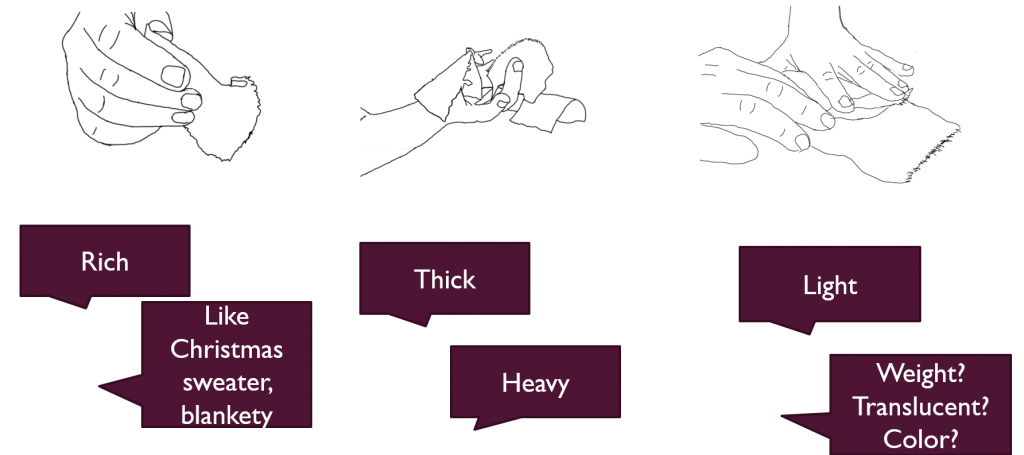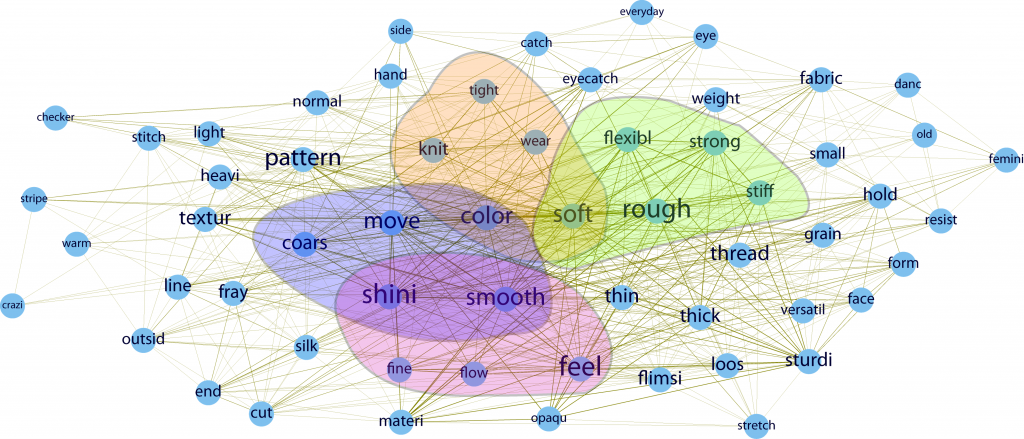
Designers may use ambiguous, contradictory, contextually driven, or even similar terms in describing physical material. There are taxonomies from fashion and costume design, but taxonomies are not serving these designers.
How can we design interfaces that capture common crafting practices that leverage multiple modalities?
Role: Lead UX Researcher
Methods
Research Goal
How can we design interfaces that capture common crafting practices that leverage multiple modalities?
Research Problem
- How do designers explore & describe physical materials?
- What implications do these practices have for online search systems?
Participants
We focused on costume and fashion designers, ranging from hobbyists, novices taking relevant courses, to experts with degrees, all in the Appalachian area. These areas are hundreds of miles away from fashion districts and centers like those in New York and Los Angeles, with limited access to a JoAnns fabric & craft store. Thus, this audience is underserved by physical fabric stores and technology, giving us an opportunity to explore their process.
Research Design
We then conducted a qualitative study on costume and fashion designers, varying from hobbyists with at least in a course relevant to fabrics, to expert designers. I asked participants to describe various fabrics at random, recording their audio and how they held the fabric, all on video.
Role
Lead UX researcher, designing and conducting all studies
Team: cross-disciplinary subject-matter experts
Duration
3 months
Tools
Qualtrics, Camtasia, Notepad, R
Skills
Survey design, Interviews, content analysis, topic modeling
I used pre-questionnaires for prior experience, videos that capture their audio and the fabric being described, and interviews that asked their process, clarification on descriptors, and how they explore fabrics for a project. I transcribed and conducted content analysis on the process and interview questions for higher-level insights.
Since I was also a designer myself, to minimize my own bias, we used topic modeling to see what connections are there between the words. I used R to generate a network of co-occurring descriptors. We also used Latent Dirichlet Allocation as a topic modeling model to help us see connections and associations with words.
Scope/Limitations
- These studies are initial and generative to the broader work; there was limited funding for participants, as a student project. The timeline was approximately a year, in order to make timely progress in my Ph.D.
- Since my PhD program was in the middle of nowhere, southwest Virginia, my participant pool was limited to the area.
- Additionally, since the inquiry was about physicality, it was not appropriate to conduct the study online. Participants needed real fabric, and this was supported through literature and studies.
Insights

One word can describe multiple properties
The above is a visualization of the LDA analysis from the words collected. Let’s look at the word “soft”. It is associated with “rough” in the green group, a more textural property. “soft” can also be a “color” in the orange cluster as well.
Contextually Ingrained words are unclear

We found contextually ingrained words like dancing, old, and feminine fabric. Is fabric old, or does it remind them of older styles? What’s a feminine fabric..? These terms are connected to some specific context that may not translate precisely designer-to-designer.
How do designers explore fabrics

Designers use a broad collection of fabrics to explore, known as a fabric bin, or a box full of diverse scrap fabrics.
The second practice observed is to use various descriptors and ideas to help communicate ideas of some fabric. Below is an example dialogue from a designer in Virginia to one in New York, who has agreed to find swatches in New York’s fashion district:
Designer A: I’m looking for something that has a nice flow, a period fabric.
Designer B: What if it’s a velvet?
Designer A: If it’s a lightweight, silky velvet, it can work. But it has to be lightweight
Ultimately, we observed designers iterating between the fabric bin approach, and using qualities to drive their design decisions.
Implications for Design

We are at the limits of what computers may know. Technology is meant to help users make sense of data, but even computing cannot know what a designer means when they deal with that work.
There are various taxonomies formed in fashion design, but none of them are served by these designers.
Embrace a designer’s own terms.
Instead of technology, taxonomy or expert/tech dictating the meaning of a descriptor, we champion systems that collaborate with a designer’s own terms, owning to how messy this can be.
Using practices that designers use in their search.
We champion introducing a huge variety of materials, mimicking the variety in a real fabric bin of swatches. Additionally, this study supports exploring conversational systems, or systems that allow the designer to express what they want and do not want, leaving everything else ambiguous.
To see these systems in action, please see my thesis for more!
Reflections
It was a refreshing study to do a mostly technology-free study, which had significant implications on technology. With more time and resources, I would have liked to compare how designers with access to fashion centers would explore materials. Additionally, with more time, I would have been happy to do more of an observational study, following designers in-situ, exploring materials for a project.